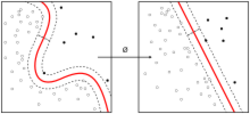Rule-based machine learning
 From HandWiki - Reading time: 3 min
From HandWiki - Reading time: 3 min
| Machine learning and data mining |
|---|
 |
Rule-based machine learning (RBML) is a term in computer science intended to encompass any machine learning method that identifies, learns, or evolves 'rules' to store, manipulate or apply.[1][2][3] The defining characteristic of a rule-based machine learner is the identification and utilization of a set of relational rules that collectively represent the knowledge captured by the system.
Rule-based machine learning approaches include learning classifier systems,[4] association rule learning,[5] artificial immune systems,[6] and any other method that relies on a set of rules, each covering contextual knowledge.
While rule-based machine learning is conceptually a type of rule-based system, it is distinct from traditional rule-based systems, which are often hand-crafted, and other rule-based decision makers. This is because rule-based machine learning applies some form of learning algorithm to automatically identify useful rules, rather than a human needing to apply prior domain knowledge to manually construct rules and curate a rule set.
Rules
Rules typically take the form of an '{IF:THEN} expression', (e.g. {IF 'condition' THEN 'result'}, or as a more specific example, {IF 'red' AND 'octagon' THEN 'stop-sign}). An individual rule is not in itself a model, since the rule is only applicable when its condition is satisfied. Therefore rule-based machine learning methods typically comprise a set of rules, or knowledge base, that collectively make up the prediction model.
See also
- Learning classifier system
- Association rule learning
- Associative classifier
- Artificial immune system
- Expert system
- Decision rule
- Rule induction
- Inductive logic programming
- Rule-based machine translation
- Genetic algorithm
- Rule-based system
- Rule-based programming
- RuleML
- Production rule system
- Business rule engine
- Business rule management system
References
- ↑ Bassel, George W.; Glaab, Enrico; Marquez, Julietta; Holdsworth, Michael J.; Bacardit, Jaume (2011-09-01). "Functional Network Construction in Arabidopsis Using Rule-Based Machine Learning on Large-Scale Data Sets" (in en). The Plant Cell 23 (9): 3101–3116. doi:10.1105/tpc.111.088153. ISSN 1532-298X. PMID 21896882.
- ↑ M., Weiss, S.; N., Indurkhya (1995-01-01). "Rule-based Machine Learning Methods for Functional Prediction". Journal of Artificial Intelligence Research 3 (1995): 383–403. doi:10.1613/jair.199. Bibcode: 1995cs.......12107W. http://jair.org/papers/paper199.html.
- ↑ "GECCO 2016 | Tutorials". http://gecco-2016.sigevo.org/index.html/Tutorials#id_Introducing%20rule-based%20machine%20learning:%20capturing%20complexity.
- ↑ Urbanowicz, Ryan J.; Moore, Jason H. (2009-09-22). "Learning Classifier Systems: A Complete Introduction, Review, and Roadmap" (in en). Journal of Artificial Evolution and Applications 2009: 1–25. doi:10.1155/2009/736398. ISSN 1687-6229.
- ↑ Zhang, C. and Zhang, S., 2002. Association rule mining: models and algorithms. Springer-Verlag.
- ↑ De Castro, Leandro Nunes, and Jonathan Timmis. Artificial immune systems: a new computational intelligence approach. Springer Science & Business Media, 2002.
 |
 KSF
KSF